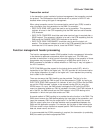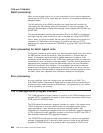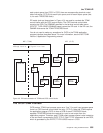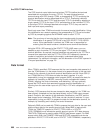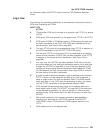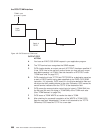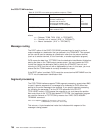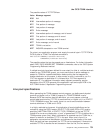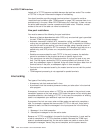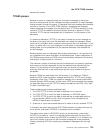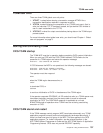The possible values of TCTTETCM are:
Value Message segment
X'00' Null
X'40' Intermediate portion of message
X'F1' First portion of message
X'F2' Last portion of message
X'F3' Entire message
X'F4' Intermediate portion of message, end of record
X'F5' First portion of message, end of record
X'F6' Last portion of message, end of record
X'F7' Entire message, end of record
X'FE' TCAM is not active
X'FF' INQUIRE attempted on non-TCAM terminal.
On output, your application program must supply the control byte in TCTTETCM for
CICS to pass to TCAM. The required command is:
EXEC CICS SET TERMINAL(4-character data-value)
TCAMCONTROL(1-character data-value)
The possible values that can be passed are as listed above. For further information
about EXEC CICS INQUIRE|SET TERMINAL commands, refer to the
CICS System
Programming Reference
manual.
If multiple terminals have been defined for one output line (that is, multiple terminals
related to one TPROCESS queue), you must ensure that an entire message is
passed to TCAM for a specific destination before putting the first segment for
another destination on the queue. In other words, an error is returned to you if a
“PUT first segment to destination A” is followed by a “PUT first segment to
destination B”. For additional information about segment processing, see the
discussion of the OPTCD operand of the application input and output DCB in the
ACF/TCAM Version 3 Application Programming
manual.
Line pool specifications
When generating the TCAM message control program, you define each physical
terminal and logical unit to TCAM by means of a TCAM TERMINAL macro.
Because CICS also requires terminal definitions, you must prepare a terminal
control table terminal entry (TCTTE) for each terminal, or logical unit, in a DFHTCT
TYPE=TERMINAL macro. As a result, there is a one-to-one correlation between
terminal definitions in TCAM and in CICS.
In a highly restricted environment, this duplication of terminal definitions can be
reduced by using the POOL feature (DFHTCT TYPE=LINE,POOL=YES), and by
specifying LASTTRM=POOL in DFHTCT TYPE=TERMINAL on the last TCTTE.
Instead of a one-to-one relationship, a “pool” of generalized TCTTEs is defined for a
TCAM process queue (line). When a transaction is received over the TCAM line, a
search is made for an available TCTTE in the pool. When one is found, it is
assigned a source terminal identification and netname for the duration of the task.
When the task has been completed, the TCTTE can be reassigned. If there are no
available TCTTEs to handle the next transaction from the line, the line remains
the CICS-TCAM interface
Chapter 26. Using TCAM with CICS 701



